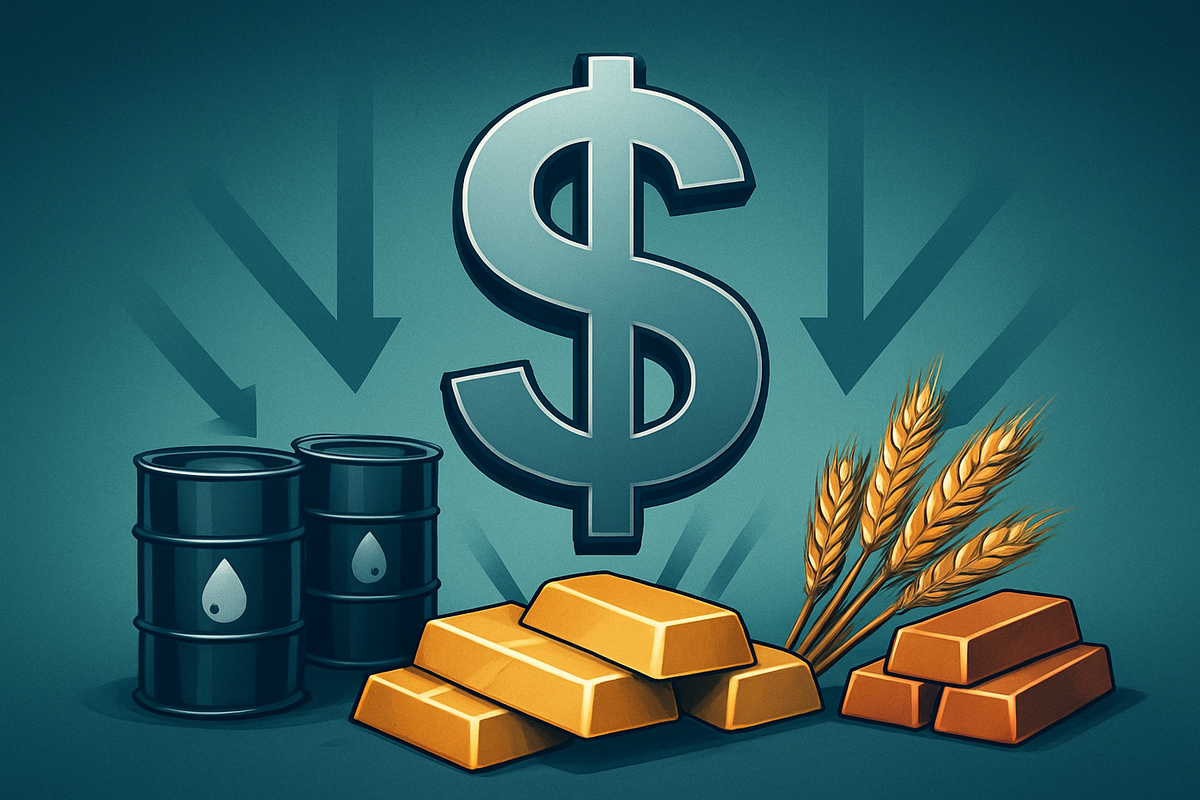The Dollar's Grip: How a Strengthening Greenback is Reshaping Global Commodity Markets
By:
MarketMinute
November 17, 2025 at 16:09 PM EST

The US Dollar, the undisputed heavyweight of global finance, is once again asserting its dominance, sending ripples across international commodity markets. As of November 17, 2025, a strengthening greenback is exerting significant downward pressure on the prices of essential raw materials worldwide, from crude oil to agricultural staples. This phenomenon, while a boon for some, presents a formidable challenge for commodity exporters, emerging economies, and multinational corporations grappling with currency translation. The immediate implication is a complex recalibration of global trade flows, corporate profitability, and inflationary dynamics, forcing market participants to re-evaluate strategies in a rapidly shifting economic landscape. The Greenback's Resurgence: A Detailed Look at the Drivers and TimelineThe recent strengthening of the US Dollar (USD) is not an isolated event but the culmination of a multi-year trend driven by a confluence of monetary policy, economic performance, and geopolitical factors. The US Dollar Index (DXY), which benchmarks the dollar against a basket of major currencies, is trading near 99.4505 as of November 17, 2025, reflecting a steady climb over the past month, even after experiencing a significant decline earlier in 2025. The primary catalyst for the dollar's robust performance has been the Federal Reserve's (Fed) aggressive monetary tightening cycle, initiated in March 2022 to combat soaring inflation. The Fed's willingness to raise interest rates more rapidly and to higher levels than many other major central banks created a substantial interest rate differential, making US assets highly attractive to global investors seeking superior yields. This "higher-for-longer" interest rate environment, coupled with the dollar's traditional role as a safe-haven asset during periods of global economic and geopolitical uncertainty (such as ongoing conflicts in Europe and the Middle East), has consistently underpinned its strength. Timeline of Key Events:
Key players driving this dynamic include the Federal Reserve, whose monetary policy decisions are paramount; other major central banks like the European Central Bank (ECB) and Bank of Japan (BoJ), whose relative policies create interest rate differentials; global investors seeking higher returns or safe havens; and multinational corporations and commodity-producing nations who are directly impacted by currency fluctuations. Initial market reactions have seen a general inverse correlation, with a strong dollar typically leading to lower dollar-denominated commodity prices, impacting the profitability of energy and agricultural producers and creating headwinds for US exports. Corporate Fortunes: Winners and Losers in a Strong Dollar EnvironmentThe strengthening US Dollar casts a long shadow over corporate earnings, creating clear winners and losers across various sectors. Companies with significant international revenue streams or those that are major commodity exporters often face headwinds, while those relying on imported raw materials or primarily serving domestic markets tend to benefit. Companies Likely to Lose:
Companies Likely to Win:
These shifts necessitate careful financial management, including hedging strategies, for multinational corporations to mitigate currency risks and optimize their cost structures. Wider Significance: Reshaping Global Economics and PolicyThe US Dollar's strengthening and its impact on commodity prices extend far beyond immediate market movements, reshaping global economic trends, influencing policy decisions, and drawing parallels to historical precedents. This phenomenon fits into broader industry trends by influencing global trade dynamics, often leading to a slowdown as US goods become more expensive for foreign buyers. It also dictates capital flows, with a strong dollar attracting investment into US financial assets, potentially diverting capital from hard assets like commodities. Furthermore, it creates contrasting inflationary and deflationary pressures: for countries importing dollar-denominated commodities, a strong dollar exacerbates inflation, while for the US, it can help mitigate domestic inflation by making imports cheaper. The ripple effects are particularly pronounced for emerging market economies. Many have significant dollar-denominated debt, making debt servicing and repayment increasingly burdensome as their local currencies weaken. This can trigger capital outflows, tighten financial conditions, and increase the cost of essential dollar-priced imports like food and energy, potentially leading to financial instability and slower growth. For US exporters, competitiveness erodes, while US importers and consumers benefit from cheaper foreign goods. Regulatory and policy implications are significant. Central banks in affected countries may be compelled to raise interest rates or intervene in foreign exchange markets to stabilize their currencies, often at the cost of domestic economic growth. Within the US, a strong dollar can fuel political debates, with some advocating for policies to weaken the currency to boost American manufacturing and exports. Historically, periods of extreme dollar strength, such as in the 1980s, have even led to international policy interventions like the Plaza Accord to curb its appreciation. The inverse correlation between dollar strength and commodity prices has been a long-standing pattern for decades, though recent periods (e.g., early 2021-mid 2022) have shown temporary divergences, highlighting the complexity introduced by other global factors like supply shocks. What Comes Next: Navigating a Shifting LandscapeLooking ahead from November 17, 2025, the interplay between the US Dollar and global commodity prices is poised for a dynamic period, with both short-term and long-term possibilities shaping market opportunities and challenges. Short-Term Possibilities (November 2025 - H1 2027): The consensus points towards a potential softening of the US dollar. J.P. Morgan Global Research anticipates further interest rate cuts by the Federal Reserve in late 2025 and 2026, potentially bringing the federal funds rate down to 2.5% by the end of 2026. This easing cycle, coupled with an expected moderation in US economic growth (forecast at 1.5% in 2025 and 1% in 2026), is likely to weigh on the dollar, potentially leading to a continued decline of the DXY. For commodities, this could mean a modest contraction in aggregate prices, but with outperformers. Natural gas and precious metals (gold and silver) are expected to benefit from lower real interest rates and geopolitical uncertainty, while oil prices may remain subdued due to oversupply. A weaker dollar would also make US agricultural exports more competitive. Long-Term Possibilities (Beyond H1 2027): The long-term outlook introduces structural shifts. Reduced investment in mining and energy in 2024-2025 could lead to significant supply-side constraints, potentially triggering a sharper upswing in commodity prices. The accelerating demand from electrification, data center build-outs, and grid reinforcement, driven by the energy transition, is expected to create a structural deficit in conductive metals like copper. Geopolitical realignments will also continue to shape long-term commodity trends. Strategic Pivots and Adaptations: Businesses will need robust currency and commodity hedging strategies, especially in energy and agriculture, to manage volatility. Supply chain resilience through diversification and cost optimization will be crucial. Investors should dynamically monitor Fed communications and dollar trends, exploit divergences in commodity prices, and focus on sector-specific opportunities in natural gas, precious metals, and potentially copper and uranium. Market Opportunities and Challenges: A weaker dollar presents opportunities for foreign buyers of commodities and enhances US export competitiveness. However, challenges include continued strain on emerging markets with dollar-denominated debt, potential global trade slowdowns, and persistent volatility. Potential Scenarios:
Wrap-Up: Navigating the Interconnected Global MarketThe strengthening US Dollar fundamentally alters the landscape of global commodity markets, creating a complex interplay of forces that demand careful attention from businesses, investors, and policymakers. The key takeaway is the dollar's enduring influence as the world's reserve currency and the primary pricing mechanism for most raw materials. While a strong dollar generally dampens commodity prices by making them more expensive for international buyers, the precise impact can vary by commodity and is increasingly influenced by underlying supply-demand dynamics and geopolitical factors. Moving forward, the market will remain highly sensitive to Federal Reserve policy decisions, particularly the pace and extent of future interest rate adjustments. Investors should closely watch for signs of sustained US economic moderation or persistent inflation, as these will be critical determinants of the dollar's trajectory. The resilience of emerging markets, the ongoing energy transition's demand for specific metals, and the evolution of global trade tensions will also be crucial factors shaping commodity prices. Strategic hedging, diversified portfolios, and a nuanced understanding of both macroeconomic trends and individual commodity fundamentals will be essential for navigating the opportunities and challenges in the months and years to come. This content is intended for informational purposes only and is not financial advice More NewsView More
D-Wave: Time to Buy the Dip? Or is the Fall Just Starting? ↗
November 24, 2025
Via MarketBeat
Tickers
QBTS

Hims, Block, and NRG Just Launched Huge Stock Buybacks ↗
November 24, 2025
Via MarketBeat

Retail Earnings Roundup: Walmart Scores, Target Slumps in Q3 ↗
November 24, 2025
Via MarketBeat

Via MarketBeat

Why Circle Stock Is Falling—and Why Some Analysts See Big Upside ↗
November 24, 2025
Via MarketBeat
Recent QuotesView More
Stock Quote API & Stock News API supplied by www.cloudquote.io
Quotes delayed at least 20 minutes. By accessing this page, you agree to the Privacy Policy and Terms Of Service.
© 2025 FinancialContent. All rights reserved.
|